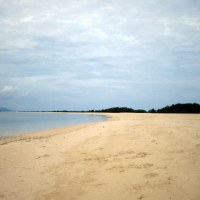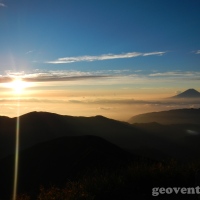Have you seen the animated film “Princess Mononoke“? It’s one of the coolest animated films ever. For me, the best part about the film was the enchanted forest setting, where the magical forest creatures come alive. My Japanese friends told me that the forest in Princess Mononoke was inspired by Yakushima island. The island was declared a World Heritage Site because of their century-old cedar trees and rich flora and fauna. Since then, it has been my dream to go to Yakushima.
M and I have been planning our Yakushima trip for more than a year. I have already prepared a detailed itinerary for a 4-day trip, complete with bus schedules, hostel rates and food budget (Yes, I’m crazy like that). Unfortunately, work, classes, and other trips got in the way and we never had that 4-day opportunity. However, when our friend visited Kyushu we just had to make the trip happen, four days or no. After all that planning, we ended up with just one day in Yakushima (less than 24 hours in fact), but it was to be one of the most memorable days ever.
Getting there is half the battle
Yakushima is an island at the southernmost part of Kyushu Island, which is southernmost of Japan’s four main islands. In short, it’s far and pretty hard to get to. From Hakata station in Fukuoka, we took the Nishitetsu highway bus to Kagoshima-chuo Station (15,000 JPY for a 4-ticket bus discount; that’s only 3,750 JPY for a 4 hour-15 minute bus ride, as opposed to the 9,660 JPY for the 95-minute shinkansen ride).
From Kagoshima, we originally planned to take the overnight Hibiscus ferry to Yakushima. The Hibiscus ferry was the cheapest option, not to mention we get to save on accommodations. *Check the Yakumonkey website for transportation options, and a lot of other Yakushima travel tips* One catch of the cheap ferry is that its embarkation point, Taniyama Port, is not located at Kagoshima city center like the other ferry services, but an hour’s drive farther southwest. Due to a series of unforeseen circumstances (weekend classes, horrible weather, and bad traffic), we were not able to catch the ferry in time. Lesson learned: bus schedules are not as reliable as the train’s. Also, weekend classes are real spoilers!
So we had no choice but to stay the night in Kagoshima. We searched online for the most convenient hostel and found Green Guest House, which is right across the Kagoshima Port going to Yakushima. That night, there was a mini concert by Guitar Panda (yes, he plays the guitar in a Panda costume, obviously!) so we hung out in the lobby for a while and tried the Kagoshima-exclusive Sakurajima Magma Soda. It was essentially a carbonated drink with chili; it’s non-alcoholic, but drink moderately still! I heard some passing warning about stomach aches…
Anyway, the next day we made sure we were at the Kagoshima port early to buy our tickets for the first trip of the toppy jetfoil to Yakushima. *We didn’t need to reserve in advance since it was the lean season, but for peak seasons make sure you book ahead of time.*
It was strange having to strap ourselves in our seats the whole trip (safety requirement), but it was a quick and smooth-sailing two hours.
Trek around Shiratani Unsuikyo: the Mononoke Forest experience
Finally, we arrived in Yakushima! We walked to Miyanoura Port Youth Hostel, which was really near the port. After checking in, we met with our two friends (Yuta and Jas) already staying at the hostel and rented a car for the group (We asked the hostel front desk for assistance with the car rental, which cost 4,500 JPY for the whole day).
The ride up to Shiratani Unsuikyo was all twists and turns on the narrow road, but the view was breathtaking!
We finally reached the entrance of Shiratani Unsuikyo Forest Ravine by noon, and we parked our car and paid the 300 JPY entrance fee. In turn, we received a pamphlet with a rough map of the area.
Given the time constraints, we decided to stick to the Genseirin Primeval Forest Hiking Trail, so we can have a feel of the Mononoke Forest, and pass by several cedar trees along the way.
And feel it we did, although I’m quite stumped trying to translate the feeling into words.
As we treaded along the path that was full of roots and fallen leaves, we passed by these big and proud cedar trees that are ancient beyond belief, standing tall in silent dignity.
And then there’s the ubiquitous moss that blankets the landscape, covering the tree trunks and the big boulders.
The different shades of green give off a tranquil vibe, especially when combined with the pristine river water and the calming sound of the stream.
I guess all of that gives the forest its enchanted feeling (and my suddenly poetic descriptions!).
We also enjoyed observing the deer walking about without a care for us human intruders.
We had a late lunch at the Shiratani hut, where there’s a water source and some benches for sitting. We heated water for some hot tea and ate our rice balls, but pretty soon the cold winter temperature was catching up with us so we headed back after a while.
We left Shiratani Unsuikyo at about 3:00 pm, still in awe of the cedar trees and the Mononoke forest, and quite happy with our little trek.
As an added bonus, we met the Yakushima monkeys on the road!
Seaside hotspring means getting naked with the ojiichans
We drove for about two hours to the southern end of the island to take a dip at their seaside onsen (hot spring). After the cold hike, we were really looking forward to a nice dip at the natural hot spring, and by the sea no less! The hot spring is open to all: men and women, young and old. I haven’t really experienced an onsen overlooking the sea, much less an onsen for both genders. I was not sure what to expect.

Hirauchi Seaside Onsen (if you look closely, you’ll see the bathers) (photo by Jasmine, because I left my camera in the car)
When we arrived there, everybody was just… naked. We also took off our clothes and left it by the rocks, but in the end I wasn’t that brave. Jas and I brought towels and after much deliberation, we didn’t take it off when we went in the water. Getting naked with your friends of the opposite gender was awkward for us girls; but the guys didn’t mind, they seem to be enjoying it, even! I guess I was weirded out by the old Japanese men (casually called ojiichan in Japanese, which literally means Grandpa) casually lounging by the onsen pools and offhandedly looking about. I’m sure they meant no malice, but for somebody not used to stripping in front of other people it was just too uncomfortable with the ojiichans watching.
However, awkwardness notwithstanding, the seaside onsen was heavenly! The hot spring water relaxed our tired muscles. Watching the sunset while lounging in the seaside bath was an unexpected bonus as well. The place and the experience is definitely memorable!
Barbeque time!
We rushed back to Miyanoura to return our rented car before the shop closed at 6:00 pm. Our friend Yuta really did a fine job getting back into town in less than an hour (don’t tell the Yakushima traffic police!). Afterwards the rental car staff brought us back to our hostel, where we finished the day with a barbeque party. Good times!
‘Til next time, Yakushima!
Early the next day, M and I ourselves out of bed to catch the Hibiscus Ferry back to Kagoshima. Our time in Yakushima was really short and sweet. For sure, we’ll be back to scale the island’s highest peak, and use that 4-day itinerary I’ve been planning since forever. See you again, Yakushima!
P.S. Somebody asked me to post my original four-day itinerary, and I’m posting it here so other people can look at it as well. Below is the itinerary with expense calculation (all figures in Japanese yen). Note that trekking times are estimated for our speed (you might be faster or slower), so take caution in following the trek schedule. Bus times are based on the 2013 bus schedule. Train times are for weekday schedules.
Day 1 FUKUOKA to KAGOSHIMA
07:00 Bus from Hakata Bus Center (3750 JPY w/4-ticket discount)
11:54 Arrival in Kagoshima-chuo station, lunch (500-1000)
12:30 Tram to Sakurajima ferry terminal (160)
12:45 Ferry to Sakurajima (150); Go around Sakurajima
15:00 Ferry to Kagoshima (150); Tram to Kagoshimachuo (160)
15:37/16:01 Train from Kagochimachuo to Sakanoue station (280)
15:57/16:21 Arrival in Sakanoue station; Taxi or walk to Taniyama port (should be at the port before 5pm, so better be early; taxis are not very frequent) (if taking taxi: 1500 JPY)
17:00 buy tickets for Hibiscus ferry (3500)
18:00 Ferry departure (overnight)
Day 2 YAKUSHIMA TREK
07:00 Arrival at Miyanoura port; breakfast (500-1000)
08:00/08:26 Bus from Miyanoura to Shiratani Unsuikyo (530)
08:30/08:56 Arrival at Shiratani Unsuikyo (300 entrance fee)
09:00 Start trek
10:30 Shiratani Hut
12:00 Kusugawa Junction
13:10 Okabu Trailhead; Lunch
13:30 Resume trek
14:10 Wilson stump
15:20 Jomon sugi
16:45 Shin-takatsuka hut, stay overnight
Day 3 SUMMIT and DESCENT
05:00 Breakfast (500-1000)
06:00 Start trek
09:00 Nagatadake junction
09:30 Miyanoura dake summit
11:45 Hana no ego; lunch
12:15 Resume trek
13:20 Yodogawa hut
14:45 Kigensugi
14:58/15:53/16:21 Bus from Kigensugi (940)
15:08/17:20/17:22 Gochomae arrival; onsen at Green Hotel (1000)
17:37/17:52/18:21 Bus from Gochomae to Miyanoura (780)
Stay at Kairakuen camping place mini-bungalow (1200)
(http://www.e-yakushima.jp/location.html)
Day 4 YAKUSHIMA to FUKUOKA
06:30 Breakfast
07:00 Taxi to Miyanoura port (3 km away, ask owner for transport options) (1500 or less by taxi)
07:20 Buy ticket for Hibiscus ferry (3200)
14:40 Arrival at Taniyama port; walk to Sakanoue station (usually no taxis unless you call for one)
15:29/16:05 Train from Sakanoue to Kagoshima-chuo station (280)
15:49/16:27 Arrival at Kagoshima-chuo Station
16:40/17:10/17:40 Bus from Kagoshima-chuo (3750 JPY w/4-ticket discount)
20:46/21:16/21:46 Arrival at Hakata Station






















































































































































































































































































